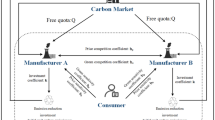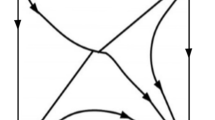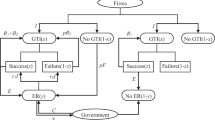Abstract
Considering the stakeholders’ pressure and the high cost/risk of green technological innovation (GTI), the tech firms are challenged over whether or not both of its components, namely green process innovation (GPsI) and green product innovation (GPdI), should be adopted. Focusing on both components raises the final product price, adversely affecting the consumers’ willingness to pay. In this study, evolutionary game theory and system dynamics were employed following a combinatory approach to analyze the evolutionary behavior of the GTI system with emphasis on both GPdI and GPsI through a feedback process. For this purpose, the tech firms’ environmental performance under evolutionary stable strategies was examined. In addition, the impact of the tech firms’ environmental performance on their evolutionary behavior and the consumers’ purchasing approach was analyzed. The simulation results indicate that tech firms exhibit different environmental behaviors in various game scenarios. In the fourth scenario, where tech firms choose both GPsI and GPdI and consumers prefer the first-type green product, the environmental performance of tech firms is superior compared to other scenarios. Conversely, in the second scenario, where tech firms opt for GPdI and consumers lean toward the second type of green product, tech firms demonstrate poor environmental performance. When consumer environmental awareness is dynamic. The evolutionary rate of tech firms and consumers exceeds that of the other scenarios. It was also found that effective government intervention can accelerate the system’s evolution.
Graphical Abstract










Similar content being viewed by others
Data availability
All data generated or analyzed during this study are included in this article.
References
Assarzadegan P, Hejazi SR, Raissi GA (2020) An evolutionary game theoretic model for analyzing retailers’ behavior when introducing economy and premium private labels. J Retail Consum Serv 57:102227
Badri Ahmadi H, Lo H-W, Gupta H, Kusi-Sarpong S, Liou JJ (2022) Analyzing interrelationships among environmental sustainability innovation factors. Clean Technol Environ Policy 24(4):1191–1207
de Jesus MAS, Aguiar Dutra ARD, Cirani CBS, Jesus KRE, Neto RCS, Guerra JBA (2022) Eco-innovation assessment of biodigesters technology: an application in cassava processing industries in the south of Brazil, Parana state. Clean Technol Environ Policy 24(3):931–948
Eghbali M-A, Rasti-Barzoki M, Safarzadeh S (2022) A hybrid evolutionary game-theoretic and system dynamics approach for analysis of implementation strategies of green technological innovation under government intervention. Technol Soc 70:102039
Eiadat Y, Kelly A, Roche F, Eyadat H (2008) Green and competitive? An empirical test of the mediating role of environmental innovation strategy. J World Bus 43(2):131–145
Friedman D (1998) On economic applications of evolutionary game theory. J Evol Econ 8(1):15–43
Friedman D (1991) Evolutionary games in economics. Econometrica: Journal of the Econometric Society 59(3): 637–666.
Hu S, Liu S (2019) Do the coupling effects of environmental regulation and R&D subsidies work in the development of green innovation? Empirical evidence from China. Clean Technol Environ Policy 21(9):1739–1749
Jamali M-B, Rasti-Barzoki M, Khosroshahi H, Altmann J (2022) An evolutionary game-theoretic approach to study the technological transformation of the industrial sector toward renewable electricity procurement: a case study of Iran. Appl Energy 318:119083
Kraus S, Rehman SU, García FJS (2020) Corporate social responsibility and environmental performance: the mediating role of environmental strategy and green innovation. Technol Forecast Soc Chang 160:120262
Li X, Hu Z, Zhang Q (2021) Environmental regulation, economic policy uncertainty, and green technology innovation. Clean Technol Environ Policy 23(10):2975–2988
Liu J, Zhao M, Wang Y (2020a) Impacts of government subsidies and environmental regulations on green process innovation: a nonlinear approach. Technol Soc 63:101417
Liu W, Yang J, Bi K (2020b) Factors influencing private hospitals’ participation in the innovation of biomedical engineering industry: a perspective of evolutionary game theory. Int J Environ Res Public Health 17(20):7442
Luo X, Zhang W (2021) Green innovation efficiency: a threshold effect of research and development. Clean Technol Environ Policy 23(1):285–298
Norang A, Eghbali MA, Hajian A, 2010. Supply chain analysis model based on system dynamics approach: a case of Iranian bicycle manufacturer, 2010. In: International Conference on Logistics Systems and Intelligent Management (ICLSIM). IEEE, pp. 1481–1485
Qiu L, Hu D, Wang Y (2020) How do firms achieve sustainability through green innovation under external pressures of environmental regulation and market turbulence? Bus Strateg Environ 29(6):2695–2714
Rehman SU, Kraus S, Shah SA, Khanin D, Mahto RV (2021) Analyzing the relationship between green innovation and environmental performance in large manufacturing firms. Technol Forecast Soc Chang 163:120481
Rosenkranz S (2003) Simultaneous choice of process and product innovation when consumers have a preference for product variety. J Econ Behav Organ 50(2):183–201
Show PL, Lau PL, Foo DC (2018) Green technologies: innovations, challenges, and prospects. Clean Technol Environ Policy 20(9):1939–1939
Singh SK, Del Giudice M, Chierici R, Graziano D (2020) Green innovation and environmental performance: the role of green transformational leadership and green human resource management. Technol Forecast Soc Chang 150:119762
Sterman J (2000) Business dynamics. McGraw-Hill, Inc, New York
Sun Z, Zhang W (2019) Do government regulations prevent greenwashing? An evolutionary game analysis of heterogeneous enterprises. J Clean Prod 231:1489–1502
Vadali S, Kim E-S (1991) Feedback control of tethered satellites using Lyapunov stability theory. J Guid Control Dyn 14(4):729–735
Wang M, Cheng Z, Li Y, Li J, Guan K (2020) Impact of market regulation on economic and environmental performance: a game model of endogenous green technological innovation. J Clean Prod 277:123969
Wang M, Li Y, Cheng Z, Zhong C, Ma W (2021a) Evolution and equilibrium of a green technological innovation system: simulation of a tripartite game model. J Clean Prod 278:123944
Wang M, Li Y, Li J, Wang Z (2021b) Green process innovation, green product innovation and its economic performance improvement paths: a survey and structural model. J Environ Manage 297:113282
Wei L, Lin B, Zheng Z, Wu W, Zhou Y (2023) Does fiscal expenditure promote green technological innovation in China? Evidence from Chinese cities. Environ Impact Assess Rev 98:106945
Wu W, Sheng L, Tang F, Zhang A, Liu J (2021) A system dynamics model of green innovation and policy simulation with an application in Chinese manufacturing industry. Sustain Prod Consum 28:987–1005
Xie X, Huo J, Zou H (2019a) Green process innovation, green product innovation, and corporate financial performance: a content analysis method. J Bus Res 101:697–706
Xie X, Zhu Q, Wang R (2019b) Turning green subsidies into sustainability: How green process innovation improves firms’ green image. Bus Strateg Environ 28(7):1416–1433
Zameer H, Wang Y, Vasbieva DG, Abbas Q (2021) Exploring a pathway to carbon neutrality via reinforcing environmental performance through green process innovation, environmental orientation and green competitive advantage. J Environ Manage 296:113383
Zarei H, Rasti-Barzoki M, Moon I (2020) A mechanism design approach to a buyer’s optimal auditing policy to induce responsible sourcing in a supply chain. J Environ Manage 254:109721
Zhang R, Sun B (2019) A competitive dynamics perspective on evolutionary game theory, agent-based modeling, and innovation in high-tech firms. Manag Decis 58(5):948–966
Zhang F, Zhu L (2019) Enhancing corporate sustainable development: Stakeholder pressures, organizational learning, and green innovation. Bus Strateg Environ 28(6):1012–1026
Zhang J, Liang G, Feng T, Yuan C, Jiang W (2020a) Green innovation to respond to environmental regulation: How external knowledge adoption and green absorptive capacity matter? Bus Strateg Environ 29(1):39–53
Zhang S, Yu Y, Zhu Q, Qiu CM, Tian A (2020b) Green innovation mode under carbon tax and innovation subsidy: an evolutionary game analysis for portfolio policies. Sustainability 12(4):1385
Zhang Y, Mao Y, Jiao L, Shuai C, Zhang H (2021) Eco-efficiency, eco-technology innovation and eco-well-being performance to improve global sustainable development. Environ Impact Assess Rev 89:106580
Funding
The authors have not disclosed any funding.
Author information
Authors and Affiliations
Contributions
Mohammad-Ali Eghbali contributed to the conceptualization, methodology, software, data curation, writing—original draft, visualization, and investigation. Morteza Rasti-Barzoki was involved in the supervision, validation, project administration, and writing—review and editing. Soroush Safarzadeh assisted in the conceptualization, methodology, validation, and review and editing.
Corresponding authors
Ethics declarations
Conflict of interest
The authors declare no competing interests.
Additional information
Publisher's Note
Springer Nature remains neutral with regard to jurisdictional claims in published maps and institutional affiliations.
Rights and permissions
Springer Nature or its licensor (e.g. a society or other partner) holds exclusive rights to this article under a publishing agreement with the author(s) or other rightsholder(s); author self-archiving of the accepted manuscript version of this article is solely governed by the terms of such publishing agreement and applicable law.
About this article
Cite this article
Eghbali, MA., Rasti-Barzoki, M. & Safarzadeh, S. An evolutionary game-theoretic approach for analysis of green innovation and environmental performance of tech firms under stakeholders’ policies based on system dynamics. Clean Techn Environ Policy (2024). https://doi.org/10.1007/s10098-024-02782-6
Received:
Accepted:
Published:
DOI: https://doi.org/10.1007/s10098-024-02782-6




